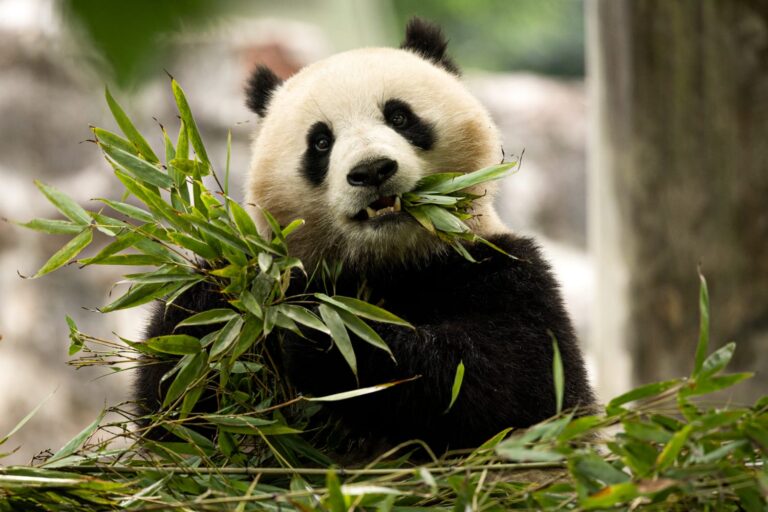YA’AN, China — A new giant panda is on its way from China to San Diego, the first to arrive in the U.S. in more than two decades, as Beijing begins to use the black-and-white bear as a diplomatic tool again.
A farewell ceremony on Wednesday near the Bifengxia panda base in southwest China’s Sichuan province was attended by Chinese and US representatives, including San Diego Zoo officials and San Diego Mayor Todd Gloria, before the panda’s crate was loaded onto a truck for the drive to the airport in the provincial capital, Chengdu.
Gloria said she was “overjoyed” to have the pandas return to the San Diego Zoo, which has cooperated with China in panda conservation for nearly three decades but has not hosted any pandas since 2019.
“This is a continuation of our long history of playing a very active role in protecting animals in general, and endangered animals like pandas in particular,” he told NBC News in an interview before the farewell ceremony at the panda base.
It would also be a step forward for relations between the United States and China, the world’s two largest economies, which have been strained by disputes over trade, technology and the status of Taiwan.
“This is a great way to move both countries in an undeniably positive direction,” Gloria said.
The pandas’ departure was carried out in secrecy to avoid drawing crowds, including from fans with an obsessive passion for pandas.
San Diego Zoo officials added that the bear, who is on loan for 10 years, will not be available to the public for several weeks while he settles in, and a date for his debut will be announced at a later date.
The two bears are Yun Chuan, a 4-year-old male, and Xin Bao, a 3-year-old female. Yun Chuan’s mother, Zhen Zhen, was born at the San Diego Zoo in 2007.
“Yunchuan is very sociable and active. He likes to interact with the keepers and often comes running when he hears footsteps,” said Huang Shan, who looks after pandas at Ya’an’s panda breeding facility.
Xin Bao is “a bit introverted, but very intelligent and agile,” Huang said. “He pays close attention to sounds like birds chirping and insects buzzing.”
The two pandas “seem to like each other,” he said, and had interacted “for quite some time” through a communication tunnel during their pre-departure quarantine period.
Last year, several US pandas, including three from the National Zoo in Washington, were repatriated to China, leaving just the four at Zoo Atlanta in the US. With those loan agreements expiring this year, there were fears the US might not get a single panda after decades of panda diplomacy with China.
Hopes were raised last November when Chinese President Xi Jinping suggested during a visit to California that more pandas might be heading to the United States, specifically San Diego.
“We’re getting on the next flight out there as soon as we can and have had some meetings to figure out what the timing is going to be,” said Paul Baribeau, president and CEO of the San Diego Zoo Wildlife Alliance, which operates the zoo.
More pandas are due to arrive at other U.S. zoos, including in Washington and San Francisco.
During their quarantine in China, Yun Chuan and Xin Bao have received medical care and training, including learning to give directions in English.
The pandas also had to get used to being in boxes before the 7,000-mile plane journey.
The pandas are accompanied by keepers and veterinarians from China and the United States, including an American who had previously visited China and “knows pandas very well,” Huang said.
The Chinese team will spend about three months in San Diego to help the pandas acclimate to their new environment.
The pandas will be well-fed during the journey: “We provide a variety of carrots, apples, cornbread and, in addition to their favourite food – bamboo – we also provide bamboo shoots, which have a nice flavour and texture,” Huang said.
But in the U.S., they’ll have to get used to a different type of bamboo than they do in Sichuan, which could be tricky, especially for Yun Chuan, who is a picky eater.
“It may take some time at first to adapt to the new diet from the U.S. side,” Huang said. “He may not eat well at first, but we believe he will adapt quickly because the San Diego Zoo has fed our pandas before.”
In preparation for the pandas’ arrival, the San Diego Zoo’s panda habitat has been “completely renovated,” expanding its size several times and becoming “enormously complex,” said Megan Owen, vice president of conservation science for the San Diego Zoo Wildlife Alliance.
“We incorporated similar topographical features to those found here, such as steep hills, lots of trees and plants,” she said in Ya’an.
The timing of when the pandas will be released to the public will depend on how long they are quarantined upon arrival and whether they need more time to acclimate to their captive environment.
“It’s up to them to let us know when they’re ready,” Owen said.
Janice McKee Frayer reported from Ya’an, China, and Jennifer Jett from Hong Kong.

